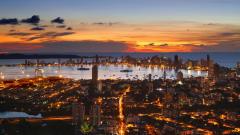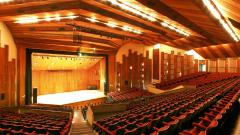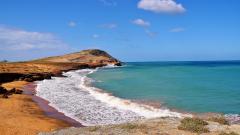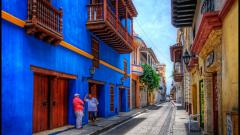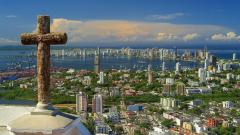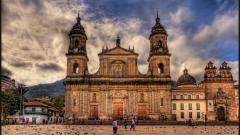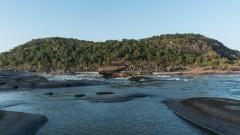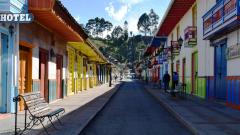 travel to colombia
travel to colombia
GENERAL CHARACTERISTICS
The Republic of Colombia, is a country located in the northwestern region of South America, it is a social and democratic state of law. It is politically organized in thirty-two decentralized departments and the capital district of Bogotá, all of which now accommodate 49.032.296 inhabitants, distributed over a total area of 1.141.748 km².
Its most populated and capital city is Bogotá with over eight million citizens. The official currency it is the Colombian Peso and the Spanish it is certified as the formal language, but depending on the geographical area, we will find different dialects of it, such as the paisa, the rolo or the llanero, among others. In addition to Spanish, there are about 66 co-official languages in the country, all of them have indigenous origin, each of them have official application in their respective territories.
The Colombian’s physical environment is very heterogeneous presenting a great variety of geographical features. As a result of this the weather is very diverse, with more of ten different typologies, existing polar areas and others with tropical weather. To classify it, we could use the altitude as a sort criterion.
In this way, we could separate it in two types: Plain weather, gathering all the altitudes below 500 metres and annual average temperatures close of 77ºF, and mountain weather, that clusters all the altitudes above 500 metres and gathering several climate conditions, from very humid to arid weather. Also, there are only two seasons: Humid (winter) and dry (summer). The rainy season occurs from April to October and the driest months are December, January and February.
HISTORY
During the pre-Columbian era, the territory was occupied by the Chibchas tribe, which were fantastic farmers and goldsmiths, they left us numerous and values art vestiges dated between 1000 b.C – 1500 b.C.
Later, already in 1502 Cristobal Colón explored the Colombian shores, following his above steps, several conquerors founded some of the cities that nowadays still playing a part of the territory, some of these examples are Santa Marta, founded in 1525, Cartagena de Indias, instituted in 1533 or Santa Fé de Bogotá, (commonly called Bogotá), that was created in 1538.
In July 20, 1810 Colombia, declared itself as an independent country, after a convulsed period, with a lot of military strifes, that involved the Army of Spain and a group of Colombian’s militiamen, leaded by Simón Bolivar, the conflict solved in favour of the Colombians, who selected their leader, president of the new state, The Great Colombia founded in 1819. The country’s actual name was proclaimed in 1866.
TOURISM
The country is divided in five different regions, that means, with respect to tourism we have multiple options.
Inside the Amazonia region we could find Colombia’s wildest part, therefore, it is the ideal region to do adventure and nature tourism enjoying its great flora and wildlife diversity, jungle landscapes and discover the indigenous lifestyle.
In the Andean region are present two of the most important cities, Bogotá that combines modern architecture (León de Greiff’s auditorium) colonial treasures (Santa Clara’s Church), cultural monuments (Gold Museum) and an endless leisure events schedule, Medellin and Bucaramanga, country’s main industrial city where are located the most famous and largest oil and coffee extractions, so we can enjoy a wide range of possibilities.
Orinoco region has six national parks (El Tuparro, Sierra de La Macarena, Tinigua, Cordillera de Los Picachos, Sumapaz and Chingaza), where we can enjoy of its vast flora and wildlife variety These are the reasons that have becomed the region in a biodiversity’s strategic enclave. Besides it is known for the existence of impressive and untouched areas, fantastic archeological sites, and the art and crafts made by indigenous tribes such as guahibos, puinaves y cuibas.
The Caribean region, is the optimum place to relax, its friendly atmosphere and free and easy lifestyle spreads for the whole area, you can dance cumbia or vallenato, enjoy of the sun, catch a boat ride, do water sports, assist to cultural events (Carnival of Barranquilla, Vallenato’s legend festival…) and eat a piece of fresh seafood fished in the nearby sea. The most popular destinations are Barranquilla, Santa Marta o Cartagena de Indias which is a rising destination and one of the better colonial cities conserved in America.
The Pacific region it is known for the enviable marine biodiversity, thanks to which, you could contemplate wonderful specimens of humpback whales or leatherback turtles. They’re viewable from the city of Chocó from July to November. Also typical are the African origin dances as juga, currulao or la salsa. The Colombian chicken Soup or the “manjar blanco” are some of the most widely eaten dishes in the area. Cali it’s the most popular city inside the region, third most important Colombian city, it’s considered a night-time and leisure tourism referent point.
We can assure that Colombia is a country that will welcome you with open arms and will offer you the best solution to whatever your tastes are. Country of contrasts that will absorb you for the joy of its people and its enriching traditions. Wherever you are, you will always find something to do and new places to discover.
REQUIRED DOCUMENTATION
Passengers must present their current passport to the Colombian authorities, in addition to having their identity document and a round-trip ticket. The authorized average stay is 90 days, and may be exceeded for another 90 days, making a total of 180 days.
Travellers coming from the countries that make up the Andean Community (Colombia, Ecuador, Bolivia, Peru and Chile) must present their identity document, their Andean Migratory Card in force, and in the case of minors their Civil Registry. Citizens of Mercosur member countries (Brazil, Paraguay, Uruguay, Argentina and Venezuela) must also present their DNI and Andean Migratory Card, in addition to the passport for minors.
Some citizens of certain countries must present a tourist visa to enter Colombia. Check the following web address if you require a visa or not: http://www.colombia.travel/en/practical-information/visa
EMBASSIES AND CONSULATES: https://www.embassypages.com/colombia
PRINCIPAL AIRPORTS OF COLOMBIA
- El Dorado International Airport, in Bogota (Codex BOG)
- Ernesto Cortissoz International Airport, in Barranquilla (Codex BAQ)
- José María Córdova International Airport, in Medellín/Rionegro (Codex MDE)
- Rafael Núñez International Airport, in Cartagena de Indias (Codex CTG)
- Alfonso Bonilla Aragón International Airport, in Palmira (Codex CLO)
- El Edén International Airport, in Armenia (Codex AXM)
- Gustavo Rojas Pinilla International Airport, in San Andrés Island (Codex ADZ)
practical information
useful information before leaving
Language
Religion
Political regime
Currency
Warnings
Documentation
Vaccines
recommendations
Recommendations before traveling to colombia
SECURITY
Colombia is not a particularly safe country, that is why it is recommended to take special care in the peripheral areas, monitor our belongings and not show signs of wealth in large urban centres and even refrain from visiting some rural areas because they are controlled by groups irregular, specifically the departments of Meta, Guaviare, Casanare and Caquetá. Likewise, it is recommended to be careful in contact with strangers, since there was an increase in the use of scopolamine in tourist areas.
Keep your personal belongings and money on public roads, and do not boast of high purchasing power.
Always hire tourist services with guides and authorized professionals.
It is recommended to take special care when taking a taxi, as we can be victims of an express kidnapping. As preventive measures we must only use those from agencies that accurately identify the taxi and the driver. The use of telephone applications such as "Easy taxi" or "Tappsi" has also spread, which work quite well and have acceptable safety indices; The application "Uber" is also very popular in Colombia.
If you intend to travel by car, try to park it in car parks or guarded areas. Most hotels, restaurants, airports and shopping centres have a parking service.
There is a substance called scopolamine (commonly known as burundanga) which is mixed with the drink, in cigarettes or it can be inhaled through the paper. This drug is used to disable the cognitive faculties of a person, to perpetrate robberies, kidnappings, or sexual assaults. That is why you must refuse any offer of food, drink, tobacco, etc. by unknown parties, in addition to avoid smelling any material that may contain that substance.
Some areas of the country are prone to volcanic and seismic activity, in addition to suffering floods and earth movements during the rainy season. In case of natural disaster always pay attention to the instructions given by the Colombian authorities.
HEALTH
It is recommended to contract health insurance, since there is no public health and medical expenses in case of hospitalization can be very high.
Outbreaks of yellow fever have been detected in the past, and in particular in the jungle areas, tropical zones of the most important river basins, so if you visit them, it is recommended to be vaccinated at least ten days before visiting the country, in addition to wearing cotton clothes that cover most of the body, and apply anti-mosquito repellent in the uncovered areas.
Some recommended vaccines for the traveller are tetanus-diphtheria, triple viral and hepatitis A.
Water is only potable in Bogotá and in the main Colombian cities. For this reason and generally, it is recommended to consume bottled water. We also recommend not eating raw vegetables or salads to avoid gastrointestinal diseases.
CLIMATE AND TEMPERATURES
The Colombian climate is diverse, since, the territory has a heterogeneous physical environment that gives rise to more than ten climatic typologies within it, being able to witness from polar to tropical climate.
If we subdivide it considering the altitude we will distinguish two types: the plain climate with altitudes lower than 500 metres and average annual temperatures of 77ºF centigrade and the mountain climate that collects altitudes higher than 500 metres with diverse climates, from very wet to dry and even aggregates. It can also be grouped into two seasons: humid (winter) and dry (summer). The rainy season occurs between April and October. The driest months are December, January and February.
BUSINESS HOURS
The shops have a schedule from Monday to Saturday from 9:00 to 12:30, and from 2:30 to 6:30. The offices and banks open from Monday to Friday from 8:00 to 12:00, and from 2:00 to 6:00.
TIPS
The tip in Colombia consists of 10% of the amount of the service. It is well seen to tip if you have been satisfied with the service provided.
The maximum effective amount that can enter the country is 10,000 US dollars per traveller, without declaring during the 180 days that it is possible to stay for tourist reasons.
The payment in dollars is not accepted in almost any establishment, but it will be able to effect the change of currency in any bank only presenting / displaying the passport. They will charge you a 3% commission for the transaction. It is also possible to do this operation in exchange houses at an exchange rate somewhat less favourable than the banking market.
ELECTRICITY
The electrical voltage in Colombia is 110 volts and the frequency 60 Hz. The types of plug are A and B. See if you need an adapter during your stay.
TELEPHONES OF INTEREST
The international prefix is +57.
If you have any complaint regarding tourism services you must go to the Delegate Superintendence for Consumer Protection that has two telephones in Bogotá 1-5870000 and 5920400, fax: 5870284. Website: http://www.sic.gov. co.
Among the telephone numbers of interest are the National Police 112, the Office of Disaster Prevention Service: 4292800 and the Colombian Red Cross: 4376300 that are available around the clock in case of emergency.
TIME ZONE
Colombia's time zone is UTC-5 throughout the year.
regions of colombia
Know all the zones and cities that you can discover in your trip

